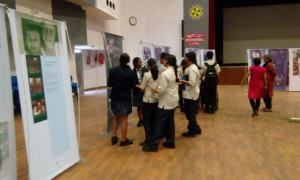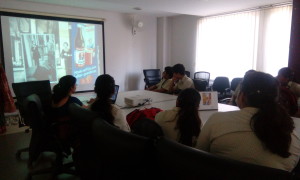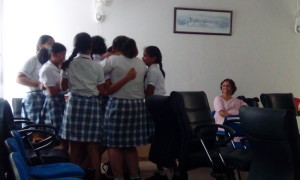‘Ma’am, exactly what is a peer guide meant to do? Do we just take the guests around the exhibition?’—a slightly hesitant question from a student before we set up the exhibition.
The international travelling exhibition ‘ Anne Frank—A History for Today’ was set up at the South City International School, Kolkata, having been to Bangalore, Chennai and Pondicherry. The exhibition was at the school from 2 May to 6 May 2016. 10 students, a few of them part of the PeaceWorks Human Rights Defenders course, were chosen to be trained as peer guides.
After setting up the exhibition, and being trained by Megha Malhotra to become peer guides, some of students came up to me with a smile on their faces. Being a peer guide wasn’t just about taking guests around the exhibition. It was something more than that. It was connecting to Anne Frank’s life, the events of the Holocaust, being able to empathize with what so many people went through and bringing that to the visitors. It was about initiating a dialogue with the people who come to see the exhibition, people who are their peers.
The 32 panels that comprise the exhibition give details of the life of Anne Frank, the Holocaust, along with photographs and excerpts from her diary. 10 schools visited the exhibition over the course of the week. Including the host school, there were around 490 visitors. After viewing the exhibition in groups guided by the peer guides, the guests were ushered into the conference room where they viewed the documentary ‘ The Short Life of Anne Frank’. A brief discussion on what they saw and how they felt took place after.
The activity that followed the discussion focused on the concept of social exclusion. The students were requested to close their eyes. The discussion facilitator and the peer guides then stuck coloured post it notes on the foreheads of some of the students, deliberately leaving some out. The students with the post its then formed groups according to the colours they had. The ones without the post its had to get into any one of the groups and the groups were instructed not to let any one in. Many strategies were employed by the students trying to get into the groups—tickling, appeals (I am your best friend, please let me in!), and trying to slip under linked arms, but most were not successful.
‘ Ma’am, it was difficult,’ ‘ I felt bad that they weren’t letting me in,’ were some of the comments from the students after the activity was over. A discussion on how the game could be representation of social exclusion followed. Social exclusion based on difference was essentially what happened in the Holocaust, on a much larger and more horrific scale. Students agreed that social exclusion could also take place in their classrooms, on a smaller scale.
An exhibition like this one works on many different levels. It brings information to the audience presented in an engaging manner. It tells a story that is one that can be felt at a personal level. It brings together students from different backgrounds—peer guides and the visitors over the story of a young girl of a similar age.
– Paroma Sengupta



